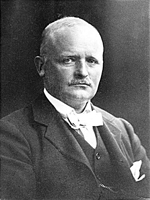Hack Kampmann
| Hack Kampmann | |
|---|---|
 |
|
| Born |
September 6, 1856 Ebeltoft, Denmark |
| Died | June 27, 1920 (aged 63) Frederiksberg, Denmark |
| Nationality | Danish |
| Occupation | Architect |
| Buildings |
Aarhus Theatre Marselisborg Palace Copenhagen Police Headquarters Ny Carlsberg Glyptotek Art Museum Frederiksberg Courthouse |
Hack Kampmann (September 6, 1856 – June 27, 1920) was a Danish architect and professor of architecture at the architecture department of the Royal Danish Academy of Fine Arts in Copenhagen.
His parents were Christian Peter Georg Kampmann, a priest, and Johanne Marie Schmidt. He entered the architecture department of the Royal Danish Academy of Fine Arts in 1873 and graduated in 1882, receiving the school's prestigious small gold medal ("Lille guldmedalje") for the design of a "Swimming bath in the Italian Renaissance style".
Kampmann went on numerous study trips throughout Europe, paid for by several scholarships, including northern Italy, Greece and Sweden. He also attended the École des Beaux-Arts in Paris in 1882 and worked with professor Jacques Hermant.
Back home in Denmark, he became a prolific architect, designing private villas, private art museums, commercial buildings, churches, as well as both small state buildings, such as post offices, and large ones such as royal palaces. Among his major works are the Provincial Archives of Northern Jutland (1890–91) in Viborg, Jutland; the Aarhus Theatre (1898–1900); Marselisborg Palace (built 1899–1902 as a wedding gift from the people to Crown Prince Christian (later Christian X); the extension to the Ny Carlsberg Glyptotek in Copenhagen; and the Copenhagen Police Headquarters, Copenhagen (1918-1922).
Kampmann was initially one of the leading Danish proponents of the national romantic style. However, during the 1920s he adopted the Nordic Classicism style, becoming one of its main initiators. His most famous work is one of the culminations of the style, the Police Headquarters in Copenhagen (1918–22) (in a team with Aage Rafn, Holger Jacobsen and F. Fredriksen) he was among the initiators of 1920s Nordic Classicism. This last building was completed after his death in summer 1920 by his two sons, Christian and Hans Jørgen Kampmann, together with Rafn. Kampmann also was responsible for a number of building restoration projects, notably Aarhus Cathedral (1907-20).
...
Wikipedia
